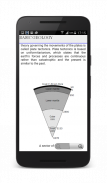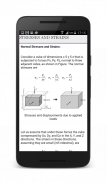









Soil Mechanics

Soil Mechanics ၏ ရွင္းလင္းခ်က္
Soil Mechanics is a subject of civil engineering. It is also considered a branch of engineering mechanics.
It also finds its uses in disciplines such as engineering geology, geophysical engineering, coastal engineering, agricultural engineering, hydrology and soil physics.
The app is a free handbook for easy understanding and faster learning of the subject. It covers 213 topics of Soil Mechanics in detail. These 213 topics are divided in 5 units.
All topics are like flashcard which is easy to browse and revise the topics specially at the time of exams and interviews. Some of topics Covered in this application are:
1. GEOTECHNICAL LESSONS FROM FAILURES
2. GEOLOGICAL CHARACTERISTICS AND PARTICLE SIZES OF SOILS
3. BASIC GEOLOGY
4. Composition of the Earth’s Crust
5. COMPOSITION OF SOILS
6. Surface Forces and Adsorbed Water
7. DETERMINATION OF PARTICLE SIZE OF SOILS
8. Particle Size of Fine-Grained Soils
9. COMPARISON OF COARSE-GRAINED AND FINE-GRAINED SOILS
10. INTRODUCTION OF SOILS INVESTIGATION
11. PHASES OF A SOILS INVESTIGATION
12. SOILS EXPLORATION PROGRAM
13. Soil Identification in the Field
14. Soil Sampling
15. Groundwater Conditions
16. Types of In Situ or Field Tests
17. PHASE RELATIONSHIPS
18. PHYSICAL STATES AND INDEX PROPERTIES OF FINE-GRAINED SOILS
19. DETERMINATION OF THE LIQUID, PLASTIC, AND SHRINKAGE LIMITS
20. SOIL CLASSIFICATION SCHEMES
21. Importance of soil compaction
22. INTERPRETATION OF PROCTOR TEST RESULTS
23. FIELD COMPACTION
24. HEAD AND PRESSURE VARIATION IN A FLUID AT REST
25. DARCY’S LAW
26. FLOW PARALLEL TO SOIL LAYERS
27. DETERMINATION OF THE HYDRAULIC CONDUCTIVITY
28. Falling-Head Test
29. Pumping Test to Determine the Hydraulic Conductivity
30. GROUNDWATER LOWERING BY WELLPOINTS
31. STRESSES AND STRAINS
32. IDEALIZED STRESS - STRAIN RESPONSE AND YIELDING
33. PLANE STRAIN AND AXIAL SYMMETRIC CONDITIONS
34. Axisymmetric Condition
35. ANISOTROPIC, ELASTIC STATES
36. Mohr’s Circle for Stress States
37. Mohr’s Circle for Strain States
38. The Principle of Effective Stress
39. Effective Stresses Due to Geostatic Stress Fields
40. Effects of Capillarity
41. Effects of Seepage
42. LATERAL EARTH PRESSURE AT REST
43. STRESSES IN SOIL FROM SURFACE LOADS
44. Strip Load
45. Uniformly Loaded Rectangular Area
46. Vertical Stress Below Arbitrarily Shaped Areas
47. STRESS AND STRAIN INVARIANTS
48. Hooke’s Law Using Stress and Strain Invariants
49. STRESS PATHS
50. Plotting Stress Paths Using Two-Dimensional Stress Parameters
51. BASIC CONCEPTS
52. Consolidation Under a Constant Load Primary Consolidation
53. Void Ratio and Settlement Changes Under a Constant Load
54. Primary Consolidation Parameters
55. CALCULATION OF PRIMARY CONSOLIDATION SETTLEMENT
56. Procedure to Calculate Primary Consolidation Settlement
57. ONE-DIMENSIONAL CONSOLIDATION THEORY
58. Solution of Governing Consolidation Equation Using Fourier Series
59. Finite Difference Solution of the Governing Consolidation Equation
60. SECONDARY COMPRESSION SETTLEMENT
61. Oedometer Test
62. Determination of the Coeffi cient of Consolidation
63. Determination of the Past Maximum Vertical Effective Stress
64. PRECONSOLIDATION OF SOILS USING WICK DRAINS
65. TYPICAL RESPONSE OF SOILS TO SHEARING FORCES
66. PRACTICAL IMPLICATIONS OF THE FAILURE CRITERIA
67. Effects of Increasing the Normal Effective Stress
68. Effects of Soil Tension
69. Coulomb’s Failure Criterion
70. Taylor’s Failure Criterion
71. Mohr - Coulomb Failure Criterion
72. INTERPRETATION OF THE SHEAR STRENGTH OF SOILS
73. LABORATORY TESTS TO DETERMINE SHEAR STRENGTH PARAMETERS
74. Conventional Triaxial Apparatus
75. Unconfi ned Compression (UC) Test
76. Consolidated Undrained (CU) Compression Test
77. POREWATER PRESSURE UNDER AXISYMMETRIC UNDRAINED LOADING
Wishing you a very happy learning.
</br></br></br></br></br></br></br></br></br></br></br></br></br></br></br></br></br></br></br></br></br></br></br></br></br></br></br></br></br></br></br></br></br></br></br></br></br></br></br></br></br></br></br></br></br></br></br></br></br></br></br></br></br></br></br></br></br></br></br></br></br></br></br></br></br></br></br></br></br></br></br></br></br></br></br></br>


























